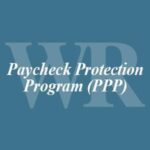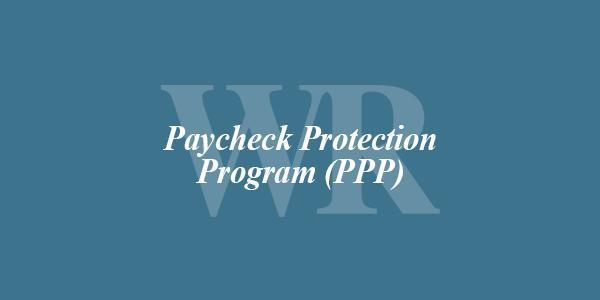
PPP Update- New Forgiveness Applications
June 26, 2020
PPP Update- Changes still coming?
July 23, 2020PPP Update- New IFR on Forgiveness- Good News for Borrowers

On Monday evening the SBA and US Dept of the Treasury published a new PPP IFR on Revisions to the Loan Forgiveness IFR. This document modifies the original forgiveness IFR to reflect changes made through the PPP Flexibility Act and provides new guidance and clarification around PPP loan forgiveness. As has been the case over the last several weeks, the SBA continues to make PPP loans more borrower friendly by broadening the opportunities for companies to achieve 100% forgiveness. In this email we will go over the new insights we’ve gained from this IFR.
FTE Reduction Exemptions Even Broader
In a previous post discussing the PPP Flexibility Act we went over the addition of two new FTE Reduction Exemptions based on employee availability and business activity that would eliminate a reduction in the loan forgiveness amount otherwise required. The new IFR re-emphasizes the broad nature of these exemptions. Here are the details of both exemptions along with documentation requirements:
- Borrowers that are able to document an inability to rehire individuals by Dec. 31, 2020 who were employees of the borrower on Feb. 15, 2020 and an inability to hire similarly qualified employees in unfilled positions can qualify for an FTE reduction exception for these positions. In order to document this exception, a borrower must inform the applicable state un-insurance office within 30 days of the employee’s rejection of the offer. Borrowers should maintain the written offer to re-hire the individual, a written record of the offer’s rejection, a written record of the efforts to hire a similarly qualified individual and any other documentation showing compliance with this exception.
- Borrowers that can document an inability to return to the same level of business activity as Feb. 15, 2020 because of compliance with Health and Human Services (HHS), Centers for Disease Control (CDC) or Occupational Safety and Health Administration (OSHA) requirements during the period March 1, 2020 through Dec. 31, 2020 can qualify for an FTE reduction exception and must provide documentation of applicable COVID Requirements or Guidance for each business location and relevant borrower financial records. The SBA recognizes that many of the sanitation requirements, social distancing standards, or other worker or customer safety requirements may be issued by state or local authorities and provides that borrowers can certify a reduction in business activity that stems directly or indirectly from the HHS, CDC, or OSHA requirements. In plain language, this allows borrowers to document a decrease in business activity as a result of state and local government shutdown orders.
Thoughts: This second exemption especially casts a very broad net that should allow many, if not most, borrowers to avoid loan forgiveness reduction based on FTE reductions. If your business has not been able to operate at pre-February 15 levels due to federal, state or local guidance or requirements, you should qualify. If you do qualify for this exemption and have not reduced salaries or wages more than 25% during your covered period, you will be able to use the PPP Loan Forgiveness Application Form 3508EZ. This is a slightly simpler application than the full forgiveness application due to not having a Schedule A Worksheet for calculating forgiveness reductions.
Using the 24-week Covered Period Isn’t Too Restrictive
In our post about the new PPP loan forgiveness applications we discussed considerations for using the new 24-week covered period vs an 8-week covered period. The perceived risk in using the 24-week period was not being able to maintain FTEs and/or salaries and wage levels for the entire 24 weeks, thus reducing forgiveness. The new IFR reduces this concern by stating that that a company does not need to wait until the end of the full 24-week period to apply for forgiveness. From the IFR, “a borrower may submit a loan forgiveness application any time on or before the maturity date of the loan – including before the end of the covered period – if the borrower has used all of the loan proceeds for which borrower is requesting forgiveness.” Note, however, that if the borrower applies for forgiveness before the end of the covered period and has reduced any salaries or wages of employees earning under $100,000 annualized per year by more than 25%, the borrower “must account for the excess salary reduction for the full 8-week or 24-week covered period.”
Thoughts: This change makes the 24-week covered period option much less restrictive. A borrower is able to apply after they have used all of their PPP funds without waiting until after the full 24-week period. This gives flexibility to a borrower to strategically apply for forgiveness at a time when salaries and wages are at a level to avoid forgiveness reductions, even if it is during the covered period. This change in conjunction with the broader FTE reduction exemptions should give companies more confidence in using the 24-week period and still achieving full forgiveness.
Owner Compensation
Also included in our post last week was information about how the amount of business owners’ compensation eligible for forgiveness varies slightly among different types of businesses. The IFR confirms these. While owners across all business types are limited to cash compensation from PPP funds for the lesser of two and a half months’ worth of 2019 compensation or $20,833 if using the 24-week covered period (8/52nds of 2019 compensation or $15,385 if using the 8-week covered period), additions for employer paid benefits or retirement contributions vary.
- C-Corporation owner-employees: can include employee retirement and health insurance contributions made on their behalf
- S-Corporation owner-employees: can only include employer retirement contributions made on their behalf
- Schedule C and F filers: capped by the amount of their owner compensation replacement, calculated based on 2019 net profit (no additional health insurance or retirement contributions)
- General partners: capped by the amount of their 2019 net earnings from self-employment (reduced by claimed Section 179 expense deductions, unreimbursed partnership expenses and depletion from oil and gas properties) multiplied by 0.9235 (no additional health insurance or retirement contributions)
We will continue to monitor changes in PPP guidance and rules and will do our best to keep you informed.
If you need assistance with your loan forgiveness calculations or applications, or you would like to strategically discuss your situation relative to PPP loan forgiveness, we are here to help. Reach out to your WR Partner or your relationship manager. You can also email our COVID-19 task force for assistance.


